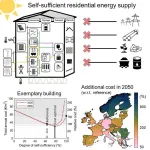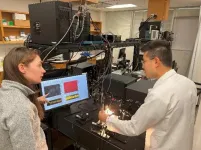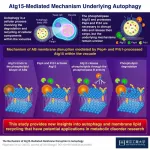(Press-News.org) It all began with basic research: While conducting laboratory experiments, a team at the Technical University of Munich (TUM) came across an active agent against multidrug-resistant bacteria with a fundamental difference to antibiotics developed to date. The researchers have since established a start-up to develop a new drug based on this agent. The entrepreneurs have now been nominated for Science Breakthrough of the Year in the Science Start-Up category at the international Falling Walls summit.
Rising numbers of bacteria are developing resistance to antibiotics. Studies have shown that hundreds of thousands of people die every year due to infections with antibiotic-resistant pathogens. One group of bacteria alone – methicillin-resistant Staphylococcus aureus (MRSA), which is commonly found in hospitals – causes tens of thousands of deaths each year.
A research team at TUM has discovered an active agent to which multi-resistant MRSA bacteria are unlikely to develop resistance. “While conventional antibiotics target either the cell wall of bacteria or their metabolic system, we aim to permanently impair protein transport and energy balance in the bacteria, which prevents them from multiplying or developing resistances,” explains Stephan Sieber, Professor of Organic Chemistry. Sieber has founded a start-up together with his former doctoral student, Dr. Robert Macsics, to continue developing the new agent.
Bacterial cell wall digests itself
The foundations for this innovation were laid in the laboratories at TUM. “It was pure basic research to begin with,” emphasizes Sieber. “We tested hundreds of different agents in cultures with Staphylococcus aureus and came across a molecule that kills the bacteria off very effectively. We then examined the mode of action of this molecule, which we call PK150.” The results showed that PK150 has a fundamentally different mode of action to conventional antibiotics. Instead of suppressing biochemical processes, PK150 stimulates the excretion of proteins in the cell wall. Key enzymes are discharged from the cells and, in effect, the cell walls begin to digest themselves. At the same time, the molecule blocks the metabolic system, which means the cell cannot store any more energy and dies. Due to this dual mode of action, it is exceptionally unlikely that bacteria will develop mutations with resistances to this agent.
“Once it became clear that this molecule is a promising candidate for the development of a new antibiotic, we both knew we wanted to develop the agent,” recalls Sieber. “It is suitable for combating Staphylococcus aureus and other multidrug-resistant bacteria that are gram-positive, which means they have a single layer cell wall.” TUM applied for a patent for the structure of the optimized molecule for the first time in 2017 while Sieber and Macsics began the search for investors. Even during the coronavirus pandemic, the two researchers secured the support of the Boehringer Ingelheim Venture Fund following a virtual pitch.
Support in a TUM Venture Lab
Soon after, in 2021, the duo founded smartbax – one of the first start-ups accepted into the new TUM Venture Lab ChemSPACE. Each TUM Venture Lab specializes in a significant technological field. Start-up teams benefit from specific technical infrastructure, tailored training programs, expertise in the relevant market and global industry networks. “The opportunity to use the infrastructure and laboratory spaces at the Venture Lab was immensely helpful for us as we took our first steps as an independent company,” says Macsics, who became the start-up’s CEO after completing his doctorate. “There’s also the Venture Lab’s network, which continuously helps us to make new contacts.”
Smartbax now has three permanent employees, with Stephan Sieber assisting as a scientific consultant. In addition to developing the active agent, the company is working on other strategies to combat drug-resistant bacteria. It aims to have its first drug candidates ready for clinical trials within a few years.
25 nominees from around the world
The Falling Walls jury identified the team’s work as one of the most potentially significant breakthroughs of the year. The eponymous charitable foundation hosts the Falling Walls Science Summit on November 9 each year. The event marks the fall of the Berlin Wall and strives to highlight the walls torn down by science to a wide audience. The summit is one of the most important events linking research with wider society and is also a key date in the scientific calendar.
Falling Walls names Science Breakthroughs of the Year in five fields of research and in the Science Start-Up category. Smartbax has been nominated along with 24 other start-ups from Europe, the Americas, Asia and Australia.
Further information:
Nominees for Science Breakthrough of the Year: https://falling-walls.com/science-summit/winners/
In addition to smartbax, a second TUM spin-off has been nominated for the Science Breakthrough of the Year in the Science Start-Up category at the Falling Walls summit. Reverion has developed micro power plants that, on the one hand, use biogas more efficiently than conventional plants. On the other hand, they can automatically switch to the production of green hydrogen or methane when there is a surplus of solar or wind energy in the grid. The start-up emerged from the BioCORE research project of a team from the Chair of Energy Systems and the Professorship of Regenerative Energy Systems at the TUM Campus Straubing for Biotechnology and Sustainability. It was supported in the TUM Venture Lab ChemSpace.
BioCORE project: http://go.tum.de/206793
Every year around 70 technology-oriented companies are founded at TUM – at the center of one of Europe’s most innovative deep tech ecosystems. TUM and UnternehmerTUM, Center for Innovation and Business Creation, provide programs tailored to the various phases of building a business – from creating the business model to management training, and from market entry to a possible IPO. The TUM Venture Labs offer an entire research ecosystem for start-up teams working in important scientific fields. Up to 30 teams can use the TUM Incubator to prepare for the launch of their companies. Through its own venture capital fonds , UnternehmerTUM invests in tech companies displaying strong potential. Meanwhile, with MakerSpace, it provides a 1500 square meter high-tech prototype workshop.
Entrepreneurship at TUM: https://www.tum.de/en/innovation/entrepreneurship
END
Start-up dedicated to developing new antibiotics
Smartbax nominated for Falling Walls award
2023-11-02
ELSE PRESS RELEASES FROM THIS DATE:
Two million European households could abandon the electrical grid by 2050
2023-11-02
Researchers report that 53% of European freestanding homes could have supplied all their own energy needs in 2020 using only local rooftop solar radiation, and this technical feasibility could increase to 75% in 2050. Publishing November 2 in the journal Joule, the study shows that there is no economic advantage for individual households to be fully self-sufficient under current or future conditions, though in some cases the costs are on par with remaining on-grid. The researchers estimate that self-sufficiency will be economically feasible for 5% (two million) of Europe’s 41 million freestanding single-family homes in 2050, ...
One sleepless night can rapidly reverse depression for several days
2023-11-02
All-nighters can cause giddy and slap-happy feelings
This effect is caused by increased dopamine release in distributed brain regions
This dopamine signal also enhances plasticity in the neuronal connections, causing a potent antidepressant effect that lasts for days
Study suggests that prefrontal cortex and its dopamine inputs are key for rapid plasticity and antidepressant effects after brief sleep loss
EVANSTON, Ill. — Most people who have pulled an all-nighter are all too familiar with that “tired and wired” ...
Circuit-specific gene therapy brings new hope for treatment of Parkinson’s disease
2023-11-02
Researchers from the Shenzhen Institute of Advanced Technology (SIAT) of the Chinese Academy of Sciences (CAS) and their collaborators have developed a gene therapy strategy to selectively manipulate Parkinson's disease-affected circuitry and attenuate the core motor symptoms of Parkinson's disease in rodent and nonhuman primate animals.
The study was published in Cell on Nov. 2.
Parkinson's disease, characterized by the loss of midbrain dopaminergic neurons, is one of the most common neurodegenerative diseases in the elderly population, affecting more than 6 million people worldwide.
Dopamine ...
Higher risk of breast cancer in women with false positive mammography result
2023-11-02
Women who receive a false positive mammography result are more likely to develop breast cancer over the subsequent 20 years, report researchers from Karolinska Institutet in a study published in JAMA Oncology. The risk is highest for women aged between 60 and 75 and who have low breast density.
In global terms, breast cancer is the most common form of cancer among women, and screening is an important tool for catching women with a tumour at the earliest possible stage. In Sweden, all women between ...
PTSD symptoms and cardiovascular and brain health in women
2023-11-02
About The Study: In this study of 274 midlife women, greater posttraumatic stress disorder (PTSD) symptoms were associated with higher carotid atherosclerosis and, among women who were APOEɛ4 carriers, greater brain small vessel disease and poorer cognitive performance. These findings point to the adverse implications of PTSD symptoms for cardiovascular and neurocognitive health among women in midlife, particularly for women who are APOEɛ4 carriers.
Authors: Rebecca C. Thurston, Ph.D., of the University of Pittsburgh, is the corresponding author.
To access the embargoed ...
Breast cancer incidence after a false-positive mammography result
2023-11-02
About The Study: The findings of this study suggest that the risk of developing breast cancer after a false-positive mammography result differs by individual characteristics and follow-up. These findings can be used to develop individualized risk-based breast cancer screening after a false-positive result.
Authors: Xinhe Mao, M.Sc., of the Karolinska Institutet in Stockholm, is the corresponding author.
To access the embargoed study: Visit our For The Media website at this link https://media.jamanetwork.com/
(doi:10.1001/jamaoncol.2023.4519)
Editor’s Note: Please ...
Practicing mindfulness can help people make heart-healthy eating choices
2023-11-02
PROVIDENCE, R.I. [Brown University] — Practicing mindfulness focused on healthy eating can be good for the heart, a new study shows, because it improves self-awareness and helps people stick to a heart-healthy diet.
When people who had elevated blood pressure participated in an eight-week mindfulness-based blood pressure reduction program for the study, they significantly improved their scores on measures of self-awareness and adherence to a heart-healthy diet compared to a control group. The results were published in JAMA Network Open.
“Participants ...
Infirmary Health partners with Ochsner Accountable Care Network to improve health outcomes for seniors across the Gulf Coast
2023-11-02
NEW ORLEANS, LA- Ochsner Health, the leading healthcare system in the Gulf South, and Infirmary Health, Alabama's largest private non-profit healthcare provider, are proud to announce a landmark partnership with Ochsner Accountable Care Network, a top-performing accountable care organization (ACO) in both clinical performance and healthcare savings for the Medicare population. The partnership aims to improve health outcomes for seniors across the Gulf Coast region.
Infirmary Health's hospitals and acute care facilities are recognized as national leaders in innovative and compassionate care for ...
Imaging advance poised to provide new insights into reproduction and infertility
2023-11-02
WASHINGTON — Researchers have developed a new optical coherence tomography (OCT) approach that can directly image coordination of tiny hair-like structures known as motile cilia in their natural environment. The ability to observe cilia dynamics in living organisms gives researchers a powerful new tool to investigate how these structures move cells and substances through the female reproductive system, as well as other functions of cilia throughout the body.
“Our new method has the potential to answer the longstanding question about cilia's ...
New study sheds light on the molecular mechanisms underlying lipid recycling within cells
2023-11-02
Recycling is just as essential in cells as in our more familiar macroscopic world. Cells continuously generate waste products and accumulate damaged components while performing regular functions. Various recycling mechanisms have evolved to ensure efficient use of these resources and help maintain homeostasis, with autophagy being one of the most well-preserved among countless animal, plant, and fungal lineages.
In the main form of autophagy, materials floating in the cell are transported to specialized organelles, such as lysosomes or vacuoles, within small capsule-like structures called ...
LAST 30 PRESS RELEASES:
Researchers identify gene that calms the mind and improves attention in mice
Artificial metabolism turns waste CO2 into useful chemicals
Ancient sea anemone sheds light on animal cell type evolution
Begging gene leads to drone food
How climate policies that incentivize and penalize can drive the clean energy transition
Can community awareness campaigns in low-resource areas improve early diagnosis of colorectal cancer?
Stardust study resets how life’s atoms spread through space
Practical education: Clinical scenario-based program development
The impact of family dynamics on eating behaviour – how going home for Christmas can change how you eat
Tracing the quick synthesis of an industrially important catalyst
New software sheds light on cancer’s hidden genetic networks
UT Health San Antonio awarded $3 million in CPRIT grants to bolster cancer research and prevention efforts in South Texas
Third symposium spotlights global challenge of new contaminants in China’s fight against pollution
From straw to soil harmony: International team reveals how biochar supercharges carbon-smart farming
Myeloma: How AI is redrawing the map of cancer care
Manhattan E. Charurat, Ph.D., MHS invested as the Homer and Martha Gudelsky Distinguished Professor in Medicine at the University of Maryland School of Medicine
Insilico Medicine’s Pharma.AI Q4 Winter Launch Recap: Revolutionizing drug discovery with cutting-edge AI innovations, accelerating the path to pharmaceutical superintelligence
Nanoplastics have diet-dependent impacts on digestive system health
Brain neuron death occurs throughout life and increases with age, a natural human protein drug may halt neuron death in Alzheimer’s disease
SPIE and CLP announce the recipients of the 2025 Advanced Photonics Young Innovator Award
Lessons from the Caldor Fire’s Christmas Valley ‘Miracle’
Ant societies rose by trading individual protection for collective power
Research reveals how ancient viral DNA shapes early embryonic development
A molecular gatekeeper that controls protein synthesis
New ‘cloaking device’ concept to shield sensitive tech from magnetic fields
Researchers show impact of mountain building and climate change on alpine biodiversity
Study models the transition from Neanderthals to modern humans in Europe
University of Phoenix College of Doctoral Studies releases white paper on AI-driven skilling to reduce burnout and restore worker autonomy
AIs fail at the game of visual “telephone”
The levers for a sustainable food system
[Press-News.org] Start-up dedicated to developing new antibioticsSmartbax nominated for Falling Walls award





